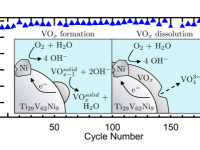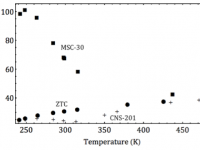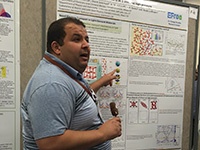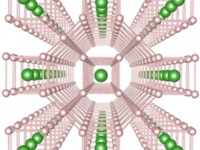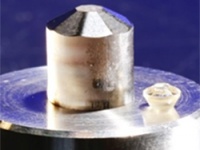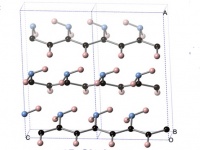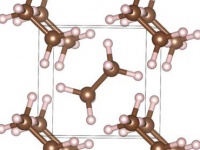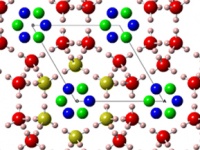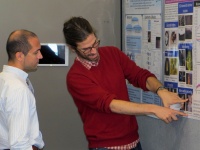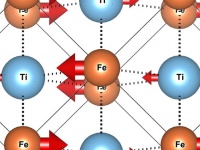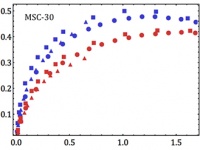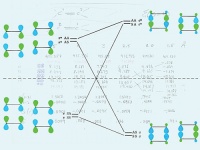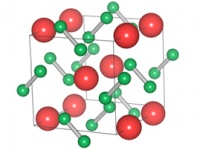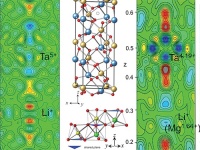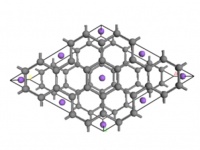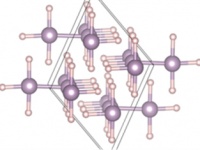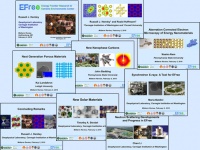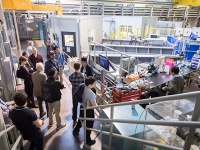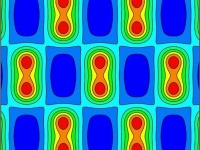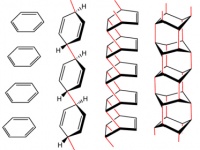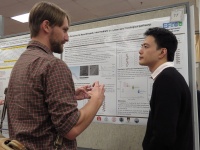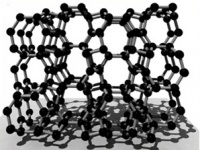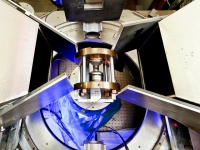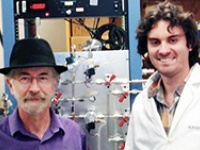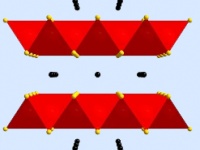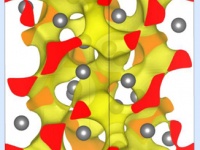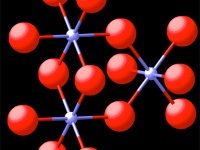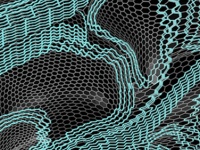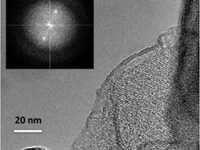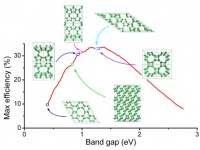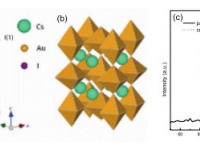Science Highlights
EFree theorists led by Postdoctoral Associate Hanyu Liu predicted that by tailoring the pressure and composition of a mixture of hydrogen and rare-earth elements, exotic metals would be created, some of which would remain superconducting to nearly room temperature. Their results were published in H. Liu et al., Proc. Natl. Acad. Sci. USA 114, 6690...
Over the past several decades, the current state-of-the-art alloys for metal hydride (MH) batteries have been LaNi5 based AB5 materials with a reversible capacity of 300 mAh/g. Since the advent of MH batteries, researchers have been searching for early transition metal hydrides to replace AB5 alloys. Replacing the heavy AB5 alloys with...
A fast, reversible, and energy efficient sorbent for the separation of carbon dioxide from mixed gas streams has been sought for energy applications in purifying flue gas and upgrading biogas. Biogas is a methane-rich gas evolved from decomposing organic matter at farms, landfills and wastewater treatment plants. While thousands of biogas...
Extreme conditions research cannot be accomplished without state-of-the-art instruments. Thus, tools must be improved in order to access new domains and to expand the range of properties measured. In high pressure neutron diffraction, for example, one limitation that sample sizes need to be much larger than is the case for x-ray diffraction. This...
The 2017 EFRC PI meeting was held at the Marriott Wardman Park Hotel in Washington DC on July 24-25. After plenary lectures on the possibilities for exascale computing and the future of quantum information science, the meeting featured highlight presentations from each of the EFRC, CMS and Hub directors, along with technical talks and poster...
Extending his original predictions for metallic hydrogen, Cornell's Neil Ashcroft later proposed that hydrogen-rich materials containing main group elements might exhibit superconductivity at accessible pressures. The hydrogen in these structures, he argued, may be considered “chemically precompressed.” These proposals, which were based on the...
Most of the entropy in materials comes from the vibrations of atoms. This vibrational entropy depends on the frequencies of phonons, or lattice vibrations, which change with P and T. Knowing the vibrational frequencies is essential to understanding the Gibbs free energy at elevated P and T. Usually the frequency of a phonon mode is assumed to...
It is difficult to overestimate the importance of silicon when it comes to computing, solar energy, and other technological applications - not to mention the fact that it is the second-most abundant element in Earth’s crust, in terms of mass percent. The most common form of silicon crystallizes in the same structure as diamond (Si-I), but other...
A new paper reports the discovery and characterization of a new iron-rich high-pressure mineral named for EFree Director Russell J. Hemley in recognition of his distinguished contributions to high-pressure research and mineral physics.
The new mineral is the iron-rich analogue of akimotoite, a mineral with MgSiO3 composition and having the...
EFree Senior Investigator Roald Hoffmann presented some recent results from his group at the January conference call of the Silver Team EFRC directors. Hoffmann's presentation focused on theoretical predictions of the behavior of electrides at high pressure.
Electrides are extended structures in which an electron has separated from an ionic core...
In a recent article in The Washington Post, EFree Director Russell Hemley weighs in on the extraordinary properties of diamond that make it so important in new scientific and technological applications.
“Forget the ring: Lab-grown diamond’s are a scientist’s best friend,” published on the front page of the Post’s February 14th issue, focuses on...
Germanium may not be a household name like silicon, but it has great potential for use in next-generation electronics and energy technology. Of particular interest are forms of germanium that can be synthesized in the lab under high pressure conditions. One of the most promising forms of germanium for practical applications, called ST12-Ge, has...
New syntheses of a novel polymeric material has been reported a multi-institutional team of researchers including EFree Affiliated Scientists from Carnegie and the Spallation Neutron Source (SNS) at Oak Ridge National Laboratory (ORNL). Experiments carried out on acetonitrile (CH3CN) using the SNAP instrument at SNS showed that under pressure up...
Understanding the behavior of dense hydrogen remains a major challenge in both condensed matter physics and energy science, and high-pressure experiments and theoretical calculations have uncovered a number of novel phenomena in this fundamental system. Theoretical work by Ivan Naumov and Russell J. Hemley reveals additional new behavior,...
Understanding and characterizing structural and bonding properties of the carbon-hydrogen (C-H) system over a broad range of conditions is crucial for developing new high-strength materials for energy applications. In addition, examination of the C-H system in extreme environments also plays an important role in the search for new materials with...
Creating new materials that efficiently store and release hydrogen is essential for further developing hydrogen-based energy technologies. Over the last several years, high-pressure studies have shown that materials based on water ice could perform this store-and-release function. New results from EFree, including a group from Carnegie, the...
After a welcoming reception on Monday evening, October 3, the schedule for October 4 and 5 included scientific sessions dedicated to the Center’s three main projects: New Nanophase Carbons, New Solar Materials, and Novel Transport in Light Element Materials. In addition, special sessions on X-ray Scattering and Neutron Scattering featured ...
The Caltech team has shown using computational theory as well as x-ray and neutron scattering scattering measurements that FeTi undergoes an unusual change in phonon dynamics associated with changes in its electronic properties at high temperatures. The effort included EFree-supported student Sally Tracy and EFree Partner Brent Fultz.
FeTi is a...
Hydrogen has long been recognized as an important energy material and component in energy systems. As such, measuring and understanding its properties over a broad range of conditions is of fundamental interest. New work published in Physical Review Letters shows that hydrogen transforms to a dark fluid at high pressures and temperatures on the...
Mesoporous and microporous adsorbents play critical roles in gas storage and separation applications. A predictive understanding of high-pressure physisorption on a variety of adsorbents would facilitate the further development of tailored adsorbents and adsorption analysis. Prior attempts at developing a predictive understanding, however, have...
The sodium counterpart to LiFePO4 has recently attracted attention as a potentially promising cathode material. Sodium is one of the major elements in the Earth’s crust and is both environmentally benign and affordable. As a result, the development of sodium analogues to lithium cathode materials is appealing, especially for large energy-storage...
A special issue of the Journal of Organic Chemistry has been dedicated to the 50th anniversary of the discovery of the role of orbital symmetry in the control of organic cycloaddition reactions. The principles underlying the conservation of orbital symmetry and the consequences for understanding the mechanisms of such reactions have been...
EFree scientists from Carnegie have discovered a new transition metal pernitride, TiN2, which is ultraincompressible (bulk modulus ~360-385 GPa), and potentially a superhard material. Using a laser-heated diamond anvil cell, titanium nitride (TiN) and nitrogen (N2) were compressed to 73 GPa and heated to 2400 K. At these extreme conditions...
Ferroelectric materials (switchable spontaneous electric polarization under an external electric-field) are also piezoelectric (convert mechanical energy into electric energy) and pyroelectric (convert a temperature change into electric energy). The combined properties of memory, piezoelectricity, and pyroelectricity, make ferroelectric materials...
A new class of high Tc superconductors having a dense carbon framework structures is predicted using first-principles calculations.
The current search for high-temperature superconductivity is now focused on materials containing low-Z elements due to the large phonon contribution necessary for BCS-type behavior. An additional strategy for...
Theoretical calculations based on the BCS phonon-mediated theory of superconductivity indicate that highly compressed solid hydrogen and main group hydrogen-rich materials can possess high Tc in predicted high pressure metallic states due to the existence of hydrogen-dominated vibrations. This proposal has motivated the search for...
The EFRC Midterm Review of EFree was held in Gaithersburg, MD on February 5. Fourteen EFree Scientists, including management, partners and students, presented talks and posters during the review. A schedule of the review can be found here:
8:30am: Russell Hemley (Carnegie) - Overview
9:15am - John Badding (Penn State) - Nanophase Carbons and...
EFree held a Center-wide Neutron Day on December 10, 2015 at the Spallation Neutron Source (SNS) at Oak Ridge National Laboratory (ORNL) in Oak Ridge, Tennessee. After introductory remarks by Richard Ibberson, Director of the Chemical and Engineering Materials Division (CEMD) and EFree Director Russell Hemley, and a tour of the SNS facility,...
EFree Associate Director Tim Strobel talks about hacking silicon's structure to make it more efficient for use in computer chips and solar panels in the November 2015 issue of New Scientist. The element may have a whole valley named after it, but the atomic structure limits its ability to conduct electricity. This means that while silicon is...
Hydrogen and lithium, along with silicon, are arguably two of the most important elements in advanced energy material technology. As a result, understanding the character of these elements in a variety of environments over a broad range of conditions is crucial for addressing many energy challenges.
Many low-Z materials are now known to exhibit...
Carbon nanothreads, the one-dimensional carbon nanomaterial synthesized slow compression of benzene to 20 GPa followed by slow decompression to atmospheric pressure, contain almost exclusively fully saturated sp3 carbons, with a C/H ratio of about 1:1. Despite this key information, the exact structure of the carbon nanothread remains uncertain,...
Producing materials by chemical vapor deposition (CVD) has become an important means of synthesis, in which high-energy molecular and atomic species generate a kinetically stable phase trapped in local energy minimum. Single crystal, polycrystalline, and nanocrystalline diamond now can be produced by microwave plasma assisted CVD (MPCVD)....
The EFRC Program held its semi-annual Principal Investigator’s Meeting on October 26-27 at the Marriott Wardman Park Hotel in Washington, DC. The meeting provided an opportunity for representatives from all 32 EFRCs to gather and share their research programs with EFRC leadership and with each other. EFree participants included both students and...
EFree's New Solar Materials project, led by EFree Associate Director Tim Strobel, is featured in the Autumn edition of the Energy Frontiers Research Centers' newsletter. The article, "Powering the Future with Solar Energy," details the work of EFree scientists in areas of high temperature and pressure research for the synthesis of new solar...
The 2015 EFree Annual Meeting was held at the Geophysical Laboratory from September 8-10. 20 talks were presented by EFree University Partners, Technical Coordinators, Students, and Postdocs over the course of the meeting. In addition, many of the Students and Postdocs presented posters on the final day.
Agenda
Instead of dreaming in the mid-19th century that one end of a chain of six sp3-hybridized carbon atoms could join itself to the other, August Kekule had instead imagined that those same chains could add carbon atoms and join themselves in bunches to become one-dimensional threads, the course of organic chemistry may have been quite different than...
Compressed hydrogen has received a great deal of attention over the last 70 years as a result of the unusual properties proposed for the metallic, monoatomic phase at high pressures, including a predicted high superconducting transition temperature and the possibility of novel quantum states associated with combined superconductivity and...
Magnetoresistance is the capacity of compounds to be changed from electrically resistant to electrically conductive depending on the presence of an external magnetic field. The ability to switch from metallic to insulating behavior makes magneto resistant materials potentially very useful for electronic and spintronic devices. “Colossal”...
Researchers at Oak Ridge National Laboratory’s Spallation Neutron Source, including EFree Technical Coordinators Reinhard Boehler and Chen Li, and EFree Affiliated Scientists Bianca Haberl and Chris Tulk, have developed technology to use diamond anvil cells to squeeze materials to more than 100 GPa while studying them with neutrons. Their work has...
EFree University Partner P. Craig Taylor and the Renewable Energy Materials Research Science and Engineering Center hosted the International Conference on Exotic Forms of Silicon on July 15-17 at the Colorado School of Mines (CSM). EFree was also represented by EFree Associate Director Tim Strobel, EFree Affiliated Scientists Bianca Haberl and ...
Quasicrystals are solids with quasiperiodic crystallographic order and rotational symmetries forbidden by classical crystallography. Because of their unusual physical properties, including high strength, quasicrystals are of interest for potential energy applications. As a result, their behavior under extreme conditions has been a subset of study...
Former EFree student Nicholas Stadie from Caltech, along with his advisor, EFree Partner Brent Fultz, and co-workers Channing Ahn and current EFree graduate student Max Murialdo, have been awarded US Patent # 9,067,848 B2, for “Nanostructured Carbon Materials for Adsorption of Methane and Other Gases.”
The patent describes methods for the...
Superconductivity is a rare physical state in which matter is able to conduct electricity - maintain a flow of electrons - without any resistance. It can only be found in certain materials, and even then it can only be achieved at very low temperatures and often only at high pressure. New research from Carnegie’s Elissaios Stavrou, Alexander...
New work from Carnegie EFree scientists Russell Hemley and Ivan Naumov hones in on the physics underlying the recently discovered fact that some metals stop being metallic under pressure. Metals are compounds that are capable of conducting the flow of electrons that make up an electric current. Other materials, called insulators, are not capable...
Over 50 years ago Russian physicist Sergey M. Stishov synthesized a new dense tetragonal form of SiO2 at high pressure for the first time. This same mineral was later found in a sample from the Barringer Meteor Crater and was named stishovite in his honor. To date, experimental studies have led to the conclusion that stishovite represents an...
Carbon exists in a variety of structural motifs as a result of its ability to adopt sp-, sp2-, and sp3-type bonding modes. Graphite, diamond, and lonsdaleite (hexagonal diamond) are well-established allotropic forms of carbon, but in recent years fullerenes, nanotubes, graphene and even amorphous carbon have received a increasing attention as a...
Natural gas is a significant component of the US energy economy, but in order for its potential to be realized in the transportation sector, the challenges of on-board natural gas storage need to be addressed. Natural gas liquefaction is an energy-intensive and expensive cryogenic process, and attaining viable energy densities by compressing...
New work from Carnegie's Ivan Naumov and Russell Hemley delves into the chemistry underlying some surprising recent observations about hydrogen and reveals remarkable parallels between hydrogen and graphene under extreme pressures. Their work is the cover story in the December issue of Accounts of Chemical Research.
Hydrogen is the most abundant...
Nearly one-tenth of the world’s electricity comes from fission-generated nuclear power, and most reactors use uranium dioxide or a mixed oxide containing 90% uranium oxide as a fuel. Although studies of the solid and its melting behavior are challenging as a result of the high temperatures required as well as the reactivity of UO2, data on the...
Silicon is the second most-abundant element in the Earth's crust. When purified, it takes on a diamond structure, which is essential to modern electronic devices--carbon is to biology as silicon is to technology. A team of Carnegie scientists including EFree Associate Director Timothy Strobel and EFree Research Scientist Duck Young Kim has...
EFree scientists from Penn State, Carnegie, and Arizona State University, have discovered how to produce ultra-thin diamond nanothreads that promise extraordinary properties, including strength and stiffness greater than that of today's strongest nanotubes and polymer fibers.
This exceedingly strong, stiff, and light material has an array of...
Carnegie's Zhisheng Zhao and collaborators from Yanshan University, Nanjing University, and the University of Saskatchewan, reported six theoretical silicon allotropes with direct or quasidirect band gaps that would more efficiently absorb and use solar energy.
Commercial silicon solar cells produced currently have only 15-20% converting...
A research team including Carnegie's Zhisheng Zhao has reported the synthesis of a new nanocatalyst, the carbon-coated face-centered cubic (fcc) ruthenium-carbon (Ru-C) nanoaloy produced by an explosion shock method.
Ruthenium and its alloys are important che
In this current research, ruthenium was mixed with carbon powder by ball-milled method...
The band structure of a material is determined by the electronic configuration of its components and their arrangement symmetry. Pressure is known to be able to alter the electronic configuration and atomic arrangements, and therefore change the band structure. A team of researchers led by Shibing Wang and Wendy L. Mao (Stanford University)...
The Department of Energy (DOE) has renewed Carnegie's Energy Frontier Research Center. The Carnegie center, Energy Frontier Research in Extreme Environments (EFree), will be headquartered at Carnegie’s Geophysical Laboratory and directed by Russell J. Hemley.
Extreme environments of pressure and temperature make radical changes to the structure...


